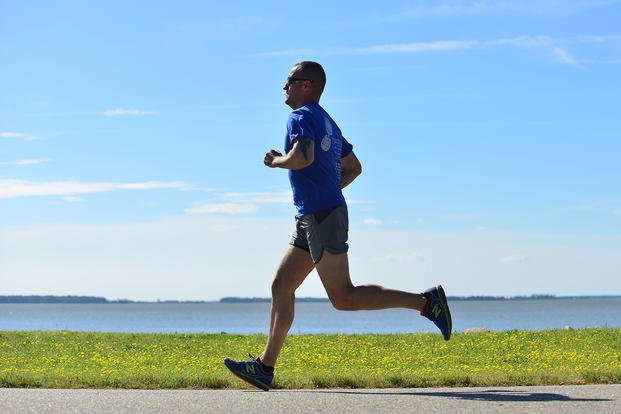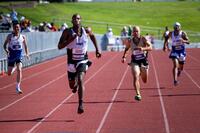It never fails that people start asking more questions about running every spring through summer. Seems like it is a natural trait many of us have ingrained in us, whether we like to run or not.
If you have run before, you will understand the many issues that occur when you run. Some of these issues arise for longer-distance race runners, but often if you are a non-runner having to pass fitness tests, the same overuse injuries can occur. This is true even if you are training only for a 1.5-mile timed run for the Navy. Below is a series of issues that runners face every year, along with links or advice to help with whatever running goals you may have:
So you might be a runner if ...
- You know what plantar fasciitis is. Foot injuries are common to runners. Usually, the cause is improper footwear or foot strike. Even if they run in running shoes with great support, many get plantar fasciitis if they wear dress or work shoes with no support the rest of the day. If you cannot walk on your heel in the morning when first out of bed, you may have plantar fasciitis.
- You have had shin splints, calf muscle tightness or Achilles' pain. Lower extremity injuries are very common mainly to those new to running or those who ramp up their miles way too fast. Consider a steady progression if long-distance running is your thing. It may take months to build up to 4-5 miles. Many often are guilty of jumping right into a five-mile run after several months off, and they wonder why their legs hurt from the knees down. Progressive running programs are the only way to build up to long distance, or you can keep it short and do sprints/faster-paced short runs.
- You have "pulled a hammy" or know what ITB and PFS stand for. Running can be painful, even when you do everything correct. Sprinters, or "those who try to sprint," inevitably will pull a hamstring muscle when running faster than normal. If you are over 30, this injury can take several months before feeling 100% again. Knee pain is so typical that there are conditions known as runner's knee (aka patellofemoral syndrome, or PFS), patella tendinitis and iliotibial band syndrome (ITB). The foam roller has helped alleviate pain and tightness enough so I didn't have to stop running. I have found treading water, with no hands but using a variety of kicks, works miracles for hip and leg pain and increasing mobility.
- Your body yells at you for the first mile, but you are golden thereafter. Especially as we age and run, you will find that the first mile or so is painful. Give yourself a good 5-10 minutes of light running, followed by a light stretch, and the running pain should be comparably nonexistent. Try a few minutes on the bike or elliptical, add in dynamic stretches and start running; that initial mile pain will not be there. In a nutshell, warm up.
- You have tried out different running styles to find what worked best for you. Everyone has a way to run. My recommendation is to find what works best for you. Experimenting with other forms of running always injured me in some way. This is my Evolution of Running.
- You have a certain level of mental toughness. There is nothing quite like running -- especially when you do not want to -- that builds mental toughness. Being a disciplined runner and getting it done daily is the very habit that will help you get through those tough tests, whether military or personal. Running is a mental test much more than a physical test. If you are a runner, you know that.
- If you like your runs long and your shorts short. We call them Silkies, Ranger Panties, or Daisy Dukes of Freedom in the military. If you run in the military, you likely will run in shorter shorts than are currently stylish. Or if you grew up in the 1980s, you just never got out of style.
- You have no posterior chain development or mobility/flexibility. The posterior chain muscles are the muscles of your back side: lower back, glutes, hamstrings, calves. Runners often use these muscles but don't exercise them in full range-of-motion strengthening programs. Squats, lunges, box jumps, deadlifts and sled pushes strengthen these muscles; help stabilize hip, knee and ankle function; and will make you faster when you are on a running cycle again. Make sure you have a lifting cycle of these muscles during your shorter running/no running cycle. Do not forget mobility and flexibility -- not just for running but for being healthy overall. Focus daily (10 minutes a day) on flexibility and mobility time.
- And finally ... you might be a runner if you cannot bench-press your body weight. Guys who run at the front of the pack are typically not the guys you see under a pull-up bar or on a bench press. If you want an offseason goal, work to do 15-20 pull-ups and bench press your body weight. Will it affect your running? Maybe a little, but the human body can do strength and endurance well at the same time. You may not be world class in either, but you can be above average in both with some periodization training.
Stew Smith is a former Navy SEAL and fitness author certified as a Strength and Conditioning Specialist (CSCS) with the National Strength and Conditioning Association. Visit his Fitness eBook store if you're looking to start a workout program to create a healthy lifestyle. Send your fitness questions to stew@stewsmith.com.
Want to Learn More About Military Life?
Whether you're thinking of joining the military, looking for fitness and basic training tips, or keeping up with military life and benefits, Military.com has you covered. Subscribe to Military.com to have military news, updates and resources delivered directly to your inbox.


















